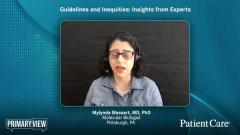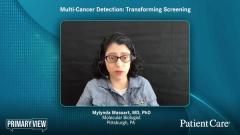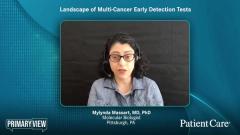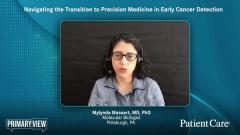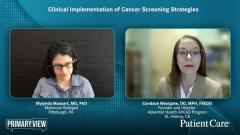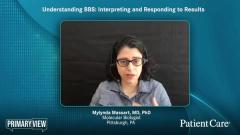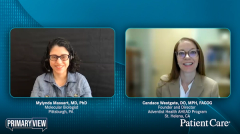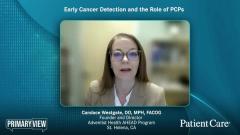
Optimizing Patient Pathways in Multi-Cancer Detection
Experts explore strategies for efficient patient care coordination through early cancer detection, highlighting cost challenges while ensuring timely diagnoses and treatments.
Episodes in this series

Transcript
Candace Westgate, DO, MPH, FACOG: Where do our roles fit? Where does a primary care physician’s role fit in a test like this and the diagnostic workup vs when is it the right time to head over to the oncologist or the specialist? So when I was thinking about this for our organization and how would we help our patients have a seamless transition, I didn’t want to reinvent the wheel when you were thinking about this. We have really good workflows in place already for [when] a screening mammogram comes back abnormal. Now we start the diagnostic workup. What do those kind of pathways look like already for an organization? And how can we streamline this process to be able to ensure that the patients get the appropriate diagnostic workup, don’t get lost, but also in the right hands, in the hands of a team that can work this up appropriately and have the knowledge about tests like this. So can you talk a little bit about what you do locally within your clinic and maybe other health systems that you’ve heard about and how they’re incorporating this and more like a circle-of-care kind of manner?
Mylynda Massart, MD, PhD: First of all, I think it’s really in the scope of primary care—family medicine, internal medicine, ob-gyn on the adult space. Really, we do the bulk of cancer screening; that is well within our scope. And so I think even though this is a genomic technology, it is still very much and well within our scope of practice to add this to cancer screening for our patients. I think that depending on the individual clinician and where they trained and how they trained, each person will have a different comfort level in how much they want to be responsible in the diagnostic evaluation. Some people may feel very comfortable handing off patients immediately to a general oncologist for that diagnostic evaluation or to a specialist based on that cancer signal of origin. Other clinicians are going to be very, very comfortable in actually working this up to kind of the nth degree and then getting the precise, specific oncologist team involved for that particular cancer. And I don’t think there’s any right or wrong in that. It can be highly dependent on our training, highly dependent on our experience, and highly dependent on our access to oncologists. I have practiced in rural places where grabbing an oncologist may not have been the easiest thing to do early on in a case and I may need to do more diagnostic management myself. And then I’m now in a place where I have oncologists right down the street that I can easily refer to and consult. So I don’t think there’s a right or wrong. I think you just have to find what you’re most comfortable with as a clinician. In terms of kind of structural ways to approach this, I think there’s a lot of different ways. At the health system where I practice, we are actually the first clinic to be exploring offering this multi-cancer early detection so we don’t have a system-wide solution in place. But I have been in communication for over a year with our oncologists. I was actually able to give them grand rounds about the technology and we have been interested in connecting over an early cancer detection tumor board so that we could review these cases and evaluate them and feel really confident that we develop a system-wide approach here to how to work up any positive screens through the diagnostic process. I have heard in going around and traveling the country and speaking about this technology from health systems that are extensively rolling out this screening across their health system, and they have put many, many systems in place, including electronic referrals and pathways that will automatically connect with downstream appropriate specialists for the diagnostic evaluation. I’m really curious to know what you’re doing, Candace, at your health system.
Candace Westgate, DO, MPH, FACOG: Thank you, Mylynda, for asking. I think I’m a bit similar to you. We’re currently offering this test within my high-risk clinic in regards to all of my gene-positive patients. We haven’t spoken about the cost of this test yet. I think this is a great opportunity to interject here with that and the limitations for this test, because there’s no societal guidelines for this. Many health insurances do not pay for this test yet. And so that leaves the cost and the financial burden to the actual patient themselves, which is just widening inequality gaps. I know an extensive amount of work has been done to ensure that that doesn’t continue for an extended period of time. So within my organization, I was able to do a fundraiser and get some philanthropy money and donations [so] that I’m able to offer this test to my patients at no cost to them if they’re extremely high risk, if they actually have an inherited genetic mutation and we’re watching it closely as a result of that. So this test for them is used in addition to, not instead of, their other cancer screenings or whatever that mutation might hold in regards to cancer risks. And what I did as I was conceptualizing this because as an ob-gyn, sure, no problem working up cervical cancer or breast cancer, we understand colon cancer, because it’s one of the things that we order. But if that cancer signal detector comes back and they hit a neck space or one of the blood cancer spaces, I’m fresh out of luck there, I’m definitely going to be raising my head and phoning a friend. And so before I started ordering this test, I got one of my oncology colleagues together. I took him out to dinner and I asked: “This is what I’m thinking about. Here is all the cancer signals that could come back positive. Here are some suggestions of how to work that up. What do you think we should do? What other blood test should we order or imaging should we order?” We came up with a road map so that I could at least be the initial workup for that patient, even as an ob-gyn, working up the head-and-neck cancer. And then we identified those specific specialists within our local organization or where we need to get some help, maybe from, for us, UCSF [University of California, San Francisco] or UC Davis—one of the bigger organizations that was doing pancreatic cancer screenings, for example. So we utilize our local resources, but then [we’re] also sort of building out this circle of care that would then help. I went out and actually discussed with these providers, educated them like you did about this new technology. And if they do have this kind of signal or a patient coming in to them with these kinds of results, don’t just brush it off. The positive predictive value is 40%. And so we really need to do our due diligence and work these patients up appropriately from that. So [we] took a step back from this, even though I’m so excited about the technology and really thought about the system and how we can ensure a good outcome for our patients, not delayed care, but not also stress on yourself, having to push special lists and providers to do the appropriate diagnostic workup. So it took a little bit in the beginning for me to feel confident with this. I know it’s the right thing to do. I know this technology is only going to improve and get better, but being at the forefront of this means extra work for us right now when it comes to that. So one other organization to discuss would be Mercy [Health] Hospitals, and they actually presented a poster presentation at ASCO [the American Society of Clinical Oncology Annual Meeting] this year talking about how they roll this out and how they actually use a high-risk clinic kind of model. So the primary care providers were the ones who were ordering the tests. And if a cancer signal came back positive, the patient automatically went to the high-risk clinic where there was a trained nurse practitioner there under the [supervision] of their oncology team that was doing the ordering and the workup based on the cancer signal of origin. And I think from start to finish, don’t quote me on this, but it was staggering. I was surprised at how quickly within a week they got the full diagnostic workup for this individual. I couldn’t even get a diagnostic mammogram done. They’ve got some tricks up their sleeve, but I think that’s a really important point in this all, that with some good foreplaning and understanding the majority of the patients getting this test are going to come back negative. So it’s not a large burden, but having a very specific pathway for those patients that do come back cancer-signal positive, will set the organization or your clinic up for great success when it comes to that.
Newsletter
Enhance your clinical practice with the Patient Care newsletter, offering the latest evidence-based guidelines, diagnostic insights, and treatment strategies for primary care physicians.

